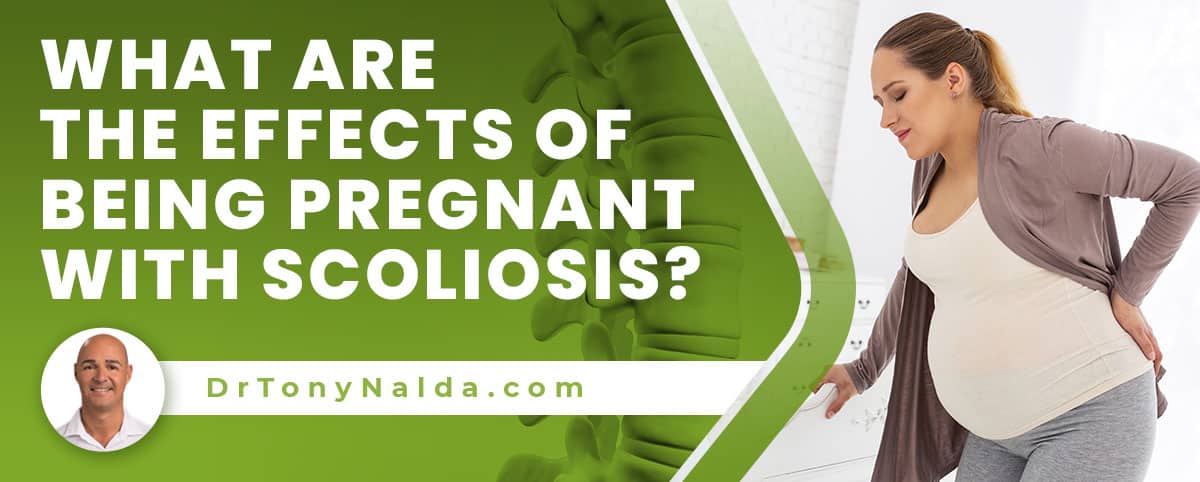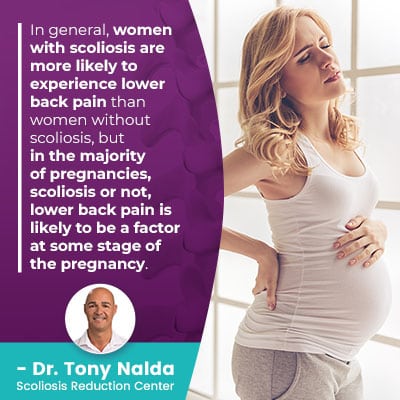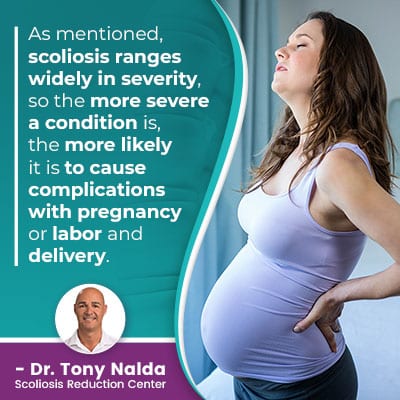What Are The Effects Of Being Pregnant With Scoliosis?

It’s natural, after receiving a diagnosis of scoliosis, to wonder how it will affect future stages of life. From female patients, I’m often asked what the effects of being pregnant are on the condition and vice versa. While scoliosis isn’t associated with fertility or delivery issues, it can increase levels of back pain, and epidurals given during labor will require some extra caution.
Women with scoliosis are just as able to conceive and deliver healthy babies as women without scoliosis; however, while all pregnant women are vulnerable to lower back pain, scoliosis can increase that vulnerability due to the condition’s uneven forces and related compression.
Let’s start our discussion of scoliosis and pregnancy with some general information about scoliosis.
What is Scoliosis?
It can be difficult to answer any specific questions regarding how scoliosis will affect the body because each and every case is as unique as the patient themselves.
To gain a better understanding of the condition’s effects, let’s talk about what makes scoliosis such a complex and highly-variable condition.
There are a number of spinal conditions that involve a loss of the spine’s natural and healthy curves, so a number of parameters have to be met to reach a diagnosis of scoliosis.
Scoliosis involves the development of an unnatural sideways spinal curve, with rotation and a minimum Cobb angle measurement of 10 degrees.
It’s the rotational element that makes scoliosis a 3-dimensional condition as the spine doesn’t just bend unnaturally to the side, but also twists from front to back, back to front.
A patient’s Cobb angle is a measurement taken during an X-ray that tells me how far out of alignment a scoliotic spine is and places conditions on a severity scale:
- Mild scoliosis: Cobb angle measurement of between 10 and 25 degrees
- Moderate scoliosis: Cobb angle measurement of between 25 and 40 degrees
- Severe scoliosis: Cobb angle measurement of 40+ degrees
- Very-severe scoliosis: Cobb angle measurement of 80+ degrees
In a healthy spine, the vertebrae (bones of the spine) are stacked on top of one another in a straight and neutral alignment, but in a scoliotic spine, some of the vertebrae are tilted unnaturally, and this disrupts the biomechanics of the entire spine.
As you can see from the wide range of Cobb angle measurements, what a patient with mild scoliosis experiences is not indicative of what others with a different severity level will face.
Part of the diagnostic process involves further classifying conditions based on key patient/condition variables that not only streamline the treatment process but also inform the crafting of customized treatment plans.
In addition to condition severity, patient age, curvature location, and condition type are classification points that shape how scoliosis is likely to affect the body.
In addition, scoliosis is a progressive condition, meaning it has it in its nature to worsen over time, particularly if left untreated or not treated proactively.
So what are the best ways to minimize the effects of scoliosis: with proactive treatment that addresses the condition’s underlying structural nature.
Now that we’ve addressed how scoliosis is diagnosed, classified and its progressive nature, what about getting pregnant with scoliosis?
Scoliosis and Fertility
 When it comes to my female patients, for those too young to worry about fertility and pregnancy, I have parents and caregivers expressing concern about the effects of being pregnant with scoliosis in the future.
When it comes to my female patients, for those too young to worry about fertility and pregnancy, I have parents and caregivers expressing concern about the effects of being pregnant with scoliosis in the future.
As scoliosis is a progressive condition, this means it’s incurable, and having scoliosis for life means being aware of how it can affect all stages of life, both present, and future.
It’s also important to understand that while scoliosis is incurable, it is highly treatable, and the more successful treatment is, the more we’re able to minimize its effects.
When it comes to getting pregnant with scoliosis, there is a lack of clear evidence showing a direct connection between scoliosis and fertility issues, and there is a lack of research suggesting that the spinal condition affects the reproductive system in any clear way.
While severe cases of scoliosis, and particularly those that are left untreated, can develop complications such as migraines, lung impairment, and digestive issues, difficulties with getting pregnant are not on the list of potential condition-related complications.
One area, however, that scoliosis can impact is back pain, which is something we know all pregnant women are likely to deal with, to varying degrees, at one point or another in their pregnancy.
Pregnancy and Back Pain
When it comes to adult scoliosis, the main symptom is back, or radicular pain felt throughout the body, and this is due to compression.
Scoliosis becomes a compressive condition once skeletal maturity has been reached in adulthood. In children and adolescents who are still growing, the constant lengthening motion of a growing spine counteracts the compressive force of the curvature, and it’s compression of the spine and its surrounding muscles and nerves that cause the majority of condition-related pain.
When talking about scoliosis back pain, we’re talking about localized back pain felt in the area of the spine with the most-tilted vertebrae at the apex of the curve or radicular pain felt throughout the body.
Remember, nerves are like branches of a tree, fanning off in multiple directions, and if a spinal nerve is exposed to uneven pressure from the unnatural curve, either at its root or anywhere along its pathway, its effects can also be felt anywhere along the affected nerve’s pathway, which can be extensive.
When it comes to my pregnant patients, there is very little I have to prepare them for; the most common complaint I hear from my pregnant patients is increased levels of back pain.
Even with keeping the possibility of increased back pain in mind, it’s not guaranteed that women with scoliosis will deal with extra back pain; this will depend largely on condition severity, the angle of trunk rotation, and can vary from patient to patient.
Basically, the level of back pain experienced by pregnant women with scoliosis will range, as it will with pregnant women who do not have scoliosis.
I’ve had some patients tell me there is no difference they noticed between an earlier pregnancy without scoliosis, and a later one with the condition, while others report their scoliosis-related back pain increases during pregnancy.
Muscles and ligaments stretch during pregnancy in preparation for labor and delivery, and weight gain also factors into back pain as there is more weight for the spine to support.
In general, women with scoliosis are more likely to experience lower back pain than women without scoliosis, but in the majority of pregnancies, scoliosis or not, lower back pain is likely to be a factor at some stage of the pregnancy.
So what about labor and delivery?
Labor and Delivery with Scoliosis
Even if a female patient has no extra issues throughout their pregnancy caused by their scoliosis, it’s only natural to wonder if the spinal condition can/will affect labor and delivery.
In the past, when women were expected to have complex deliveries due to the presence of another medical condition, they were often automatically scheduled for C-sections, but now that we know so much more about scoliosis, and the relevant risks of labor and delivery, that has since changed.
It is important to note, however, that while scoliosis doesn’t guarantee the necessity of a C-section, having scoliosis does increase the likelihood.
In general, women with scoliosis can safely deliver healthy babies vaginally without condition-related complications.
There are certain types of postural deviation, related to scoliosis, that can complicate things when it comes time to deliver; for example, if a woman has a tilted pelvis and uneven hips as a result, it’s good to be aware that there might be an increased number of stalls as the baby’s position can be affected.
As mentioned, scoliosis ranges widely in severity, so the more severe a condition is, the more likely it is to cause complications with pregnancy or labor and delivery.
In some cases of severe scoliosis, lung impairment can become an issue, and although this is not a common complication of scoliosis, for those experiencing it, settling into regular rhythmic breathing patterns for pain management during labor can pose an extra challenge.
Speaking of pain management, what about getting an epidural during labor?
Getting an Epidural with Scoliosis
 The method of pain relief during labor that will need to be approached with caution by women with scoliosis is the mighty epidural.
The method of pain relief during labor that will need to be approached with caution by women with scoliosis is the mighty epidural.
Epidurals are the gold standard when it comes to not feeling the pain associated with labor and those final big pushes; getting an epidural involves getting an injection containing a mix of steroid and numbing agents into a specific area of the spinal cord.
For women with scoliosis who are in labor, an anesthesiologist will need to be aware of the scoliosis because it means the spine has an unnatural sideways spinal curve, so where they inject on an average patient might need to be adjusted slightly to account for the misalignment of an atypical spine.
Epidurals that aren’t administered correctly, or that don’t make it into the precise area of the spinal cord needed for optimal pain relief can carry risks of paralysis, inadequate freezing, blood pressure issues, and difficulty breathing.
An X-ray image of the patient’s spine will need to be referred to ensure the anesthesiologist knows the precise position of the spine and the area to be injected, and when done correctly, an epidural can still be safely administered into the space around the dura mater of the spinal cord: exactly where it needs to go.
So while scoliosis can complicate the journey from conception to delivery, current research is somewhat mixed on the subject, and in general, supports that scoliosis isn’t guaranteed to overly complicate the process.
Conclusion
So what are the effects of being pregnant with scoliosis? The answer to any questions regarding how patients experience life with scoliosis will vary from one person to the next.
There are a number of important variables that factor into how scoliosis affects the body: patient age and overall health, curvature location, condition type (causation), and severity.
With so many fluctuating variables, the complex nature of scoliosis necessitates the customization of effective treatment plans.
For women with scoliosis wondering how their condition will affect pregnancy, the most likely answer is not at all, but in some cases, there does seem to be a connection between increased lower back pain. For women who opt for an epidural, they simply need to ensure the anesthesiologist is aware of their scoliosis and has an up-to-date X-ray of the spine for precision.
There is a lack of clear evidence that says women with scoliosis will find it harder to get pregnant, have harder pregnancies, labor challenges, or will experience increased delivery complications.
Here at the Scoliosis Reduction Center, I guide my patients through every stage of treatment, including pregnancy, and when it comes to the effects of scoliosis on a pregnancy, as is the case with all patients, the condition’s effects can be minimized with adequate care and proactive treatment.
Dr. Tony Nalda
DOCTOR OF CHIROPRACTIC
After receiving an undergraduate degree in psychology and his Doctorate of Chiropractic from Life University, Dr. Nalda settled in Celebration, Florida and proceeded to build one of Central Florida’s most successful chiropractic clinics.
His experience with patients suffering from scoliosis, and the confusion and frustration they faced, led him to seek a specialty in scoliosis care. In 2006 he completed his Intensive Care Certification from CLEAR Institute, a leading scoliosis educational and certification center.
About Dr. Tony Nalda
 Ready to explore scoliosis treatment? Contact Us Now
Ready to explore scoliosis treatment? Contact Us Now





